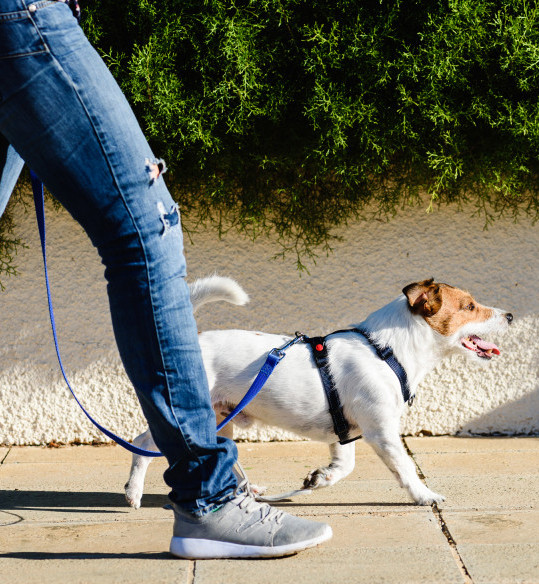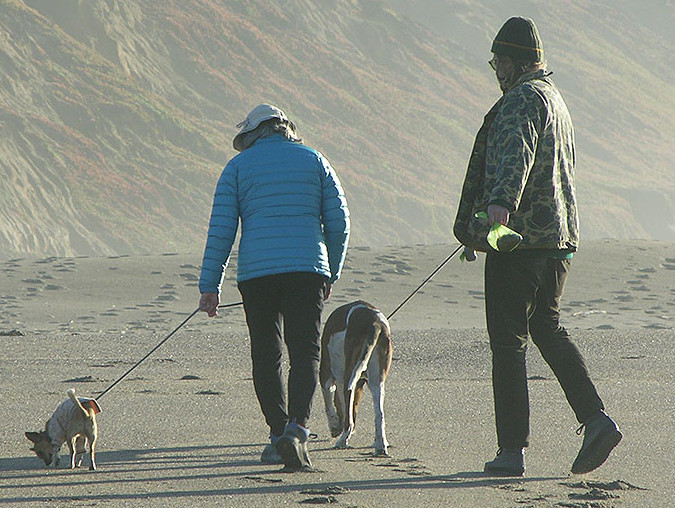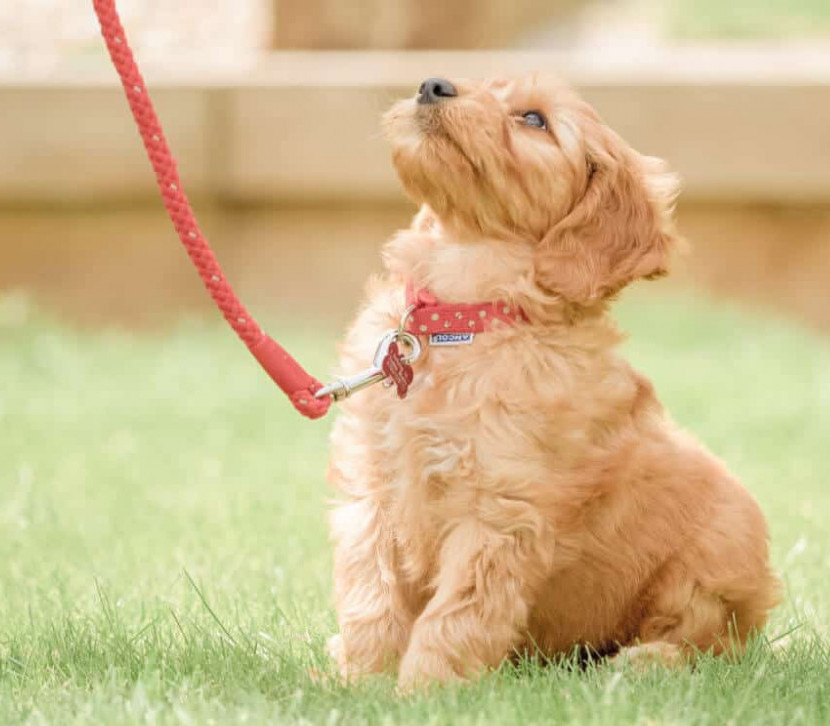“Oh no!!! This is NOT my idea of fun. . .”

Proper leash walking with your dog doesn’t come naturally. This is a skill that you must teach your dog. Dog leash training techniques require time, consistency and patience.
This is a skill that you must teach your dog. Dog leash training techniques require time, consistency and patience.
This is what proper leash walking looks like:
Notice the looseness of the leash. There is no tension or pulling. Your dog is walking comfortably at your side, matching your pace. This is what’s known as “loose leash walking”. It takes practice to teach your dog to do this properly.
With correct training, your dog will master this skill. Together, your efforts will be rewarded with lots of enjoyable walks ahead. Notice the smile on this pooch’s face?
Now let’s go for a walk!
What You’ll Need:
1. Well fitted collar or harness
2. Short leash (4′ or 6′), not a retractable type
3. Pouch for holding training treats and waste bags
4. Later, you may need a Dog Water Bottle (for extended walks or walking in warmer weather to keep your dog hydrated)
Puppy Leash Training
If you are training a puppy, the first step is getting them accustomed to wearing a collar and leash. These are new, unfamiliar items for a puppy and require a proper introduction. First, outfit your puppy with a well-fitted collar or harness. Make sure it is sized correctly: not too large for them to slip out of or too snug to be uncomfortable. Allow them time to get accustomed wearing their collar/harness.
Next introduce them to their leash. Show them the leash, let them investigate it, attach it to their collar/harness and allow them to drag it around the house to get them comfortable walking around with it. With this accomplished, take a hold of the leash and have your puppy follow you around. This is the beginning of teaching them proper leash walking.
Heeling
Heeling is the first skill of proper leash walking to teach your puppy or any newly acquired, untrained dog. The “Heel” command is teaching them to walk closely alongside you. Start this training inside the house where it’s easier for them to focus on you and not be easily distracted.
Start by putting your dog in a sitting position next to you. Take one step forward, give the command “Heel”. Gently pull them towards you. As they follow your step, immediately praise them and reward them with a treat. Repeat this process, one step at a time, until your dog gets the hang of it. Should your dog walk ahead of you or start wriggling around, put them in a sitting position and start over again.
Once your dog masters this inside the house, venture outside to the yard or driveway. Pick a familiar location to minimize distraction and continue with their “Heel” training. As your dog successfully learns to walk alongside you, slowly extend the length of their leash to where they continue to consistently walk beside you. Whenever they fail to do so, put them in a sitting position, then start over again. Be patient with them. This training requires time and consistency. Once your dog has mastered this very important skill, congratulate yourselves! This is quite an accomplishment and they are now ready to progress onward with their leash walk training.
Two Type of Walks: Structured Walks and Free Walks
Structured walks are specifically designed for walking, nothing else. No potty breaks, no sniffing, no mingling with other dogs or people, no attention given to distractions, etc. It is strictly walking. This is mentally challenging for your dog and requires your full attention as well.
Free walks, on the other hand, allow your dog out of the “heel” position. The only rule during free walks is that your dog does not pull on the leash. During a free walk, your dog can take a potty break, sniff, look around, mark locations, greet other dogs and people, lay down, rest, etc.
Structured Walks
The purpose of a structured walk is to provide leadership for your dog and teach them to follow your instructions and walk alongside you in a “heel” position. Start off with allowing your dog to go potty. After this, you can now begin your training. Follow the same “Heel” training procedure used indoors. Your dog’s job is to walk beside you in a “heel” position focusing only on you and your commands. This is very challenging and requires your dog’s full attention. Also, it requires you to be 100% attentive to training your dog. No other distractions such as talking on your phone or to other pedestrians, listening to music, whatever.
Once your dog masters this, challenge them by changing direction or changing pace. Your training is going well when your dog coordinates their movements with yours. Whenever your dog starts to pull ahead of you or in another direction, immediately stop. Do not continue until the leash slackens and your dog follows you in the direction you want to go. Praise and reward your dog when they obey your instructions. Be consistent during this training to avoid confusing your dog.
The goal of this walk is not getting to a destination. The goal is to have your dog “heel” for the entire duration of the walk. While this provides physical exercise, it’s primary intention is to engage your dog’s concentration and obedience.
Free Walks
In comparison to a Structured Walk, a Free Walk allows for more relaxation and less restriction. Here, your dog is not required to be in a “Heel” position. The only rule is that they are not allowed to pull on the leash. If this happens, stop immediately. Don’t proceed until the leash slackens and your dog follows you in the direction you want to go. Then, praise and reward them immediately.
Other than pulling on the leash, your dog is allowed to change sides, go potty, stop and observe, mark spots, greet other dogs and people, rest, etc. They are allowed the freedom to do as they please, with the exception of pulling on their leash.
A Free Walk should only be allowed once your dog has mastered the skills required in a Structured Walk. You must clearly communicate that they’re going on a Free Walk. They must comprehend the type of walk and associate the behavior that is expected of them. This is to prevent any confusion on your dog’s part, and a consequent lapse in their behavior, when you are taking them on a Structured Walk instead.
Conclusion
Our dogs need their daily walks. Not just for physical exercise, but also for mental engagement and obedience training as well. Dogs that are deprived of daily walks are more predisposed to behavioral problems including aggression, disobedience or hyperactivity.
Help keep our dogs happy and healthy by walking them daily. Not only does this improve their quality of life, it further provides quality time with your dog and strengthens the bond you share.
To you and your pooch, “Go walking, be happy!”


We have been considering getting a puppy but I know that there is a lot of work and training involved. How old should they be before you recommend beginning leash training? And how long would you say it generally takes before they start to get the hang of it? A great article to give people insight that are just beginning!
It’s great that you are thinking of getting a puppy! You are correct in anticipating that a good amount of work and training is involved. To raise a puppy correctly requires time, patience and consistency. To begin, you can start as soon as your puppy is settled and comfortable into their new home. Start by getting them used to wearing first the collar, then the attached leash. Put it on and let them just get used to walking around the house. From there, gently start leash walking training indoors by first getting them to follow you around.
Please read my recommendations and cautions included in my article “Socializing a New Puppy – Puppy Vaccination Status” with regards to walking them in public before they have completed their series of puppy vaccinations. This is very important in protecting their developing disease immunity.
The next skill to start teaching them is to “Heel”. The more often you practice with your puppy, the quicker they will pick it up. Remember they are babies. Their attention span is brief, so limit the time spent in each session. Repeat these short sessions often through out the day. Be generous with praise and a treat whenever they behave correctly. When they make a mistake, be calm and gentle when correcting them. Simply stop, and start again from the beginning.
Your mantra is “Time, patience and consistency”. If your training is done correctly, your puppy will pick it up quickly because their wanting to please you is instinctive. Best wishes and keep me posted on your progress!